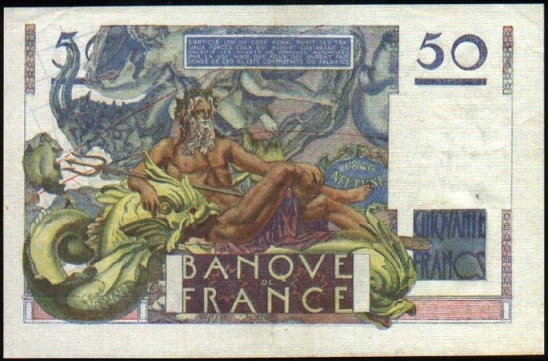France - 50 francs (1946)
France - 50 francs - 1946-1951 - P127


Urbain Jean Joseph Le Verrier (1811 – 1877) was a French mathematician who specialized in celestial mechanics. Le Verrier's most famous achievement is his prediction of the existence of the then unknown planet Neptune, using only mathematics and astronomical observations of the known planet Uranus. Encouraged by physicist Arago, Director of the Paris Observatory, Le Verrier was intensely engaged for months in complex calculations to explain small but systematic discrepancies between Uranus's observed orbit and the one predicted from the laws of gravity of Newton. At the same time, but unknown to Le Verrier, similar calculations were made by John Couch Adams in England. Le Verrier announced his final predicted position for Uranus's unseen perturbing planet publicly to the French Academy on 31 August 1846, two days before Adams's final solution was privately mailed to the Royal Greenwich Observatory. Le Verrier transmitted his own prediction by 18 September in a letter to Johann Galle of the Berlin Observatory. The letter arrived five days later, and the planet was found with the Berlin Fraunhofer refractor that same evening, 23 September 1846, by Galle and Heinrich d'Arrest within 1 degree of the predicted location near the boundary between Capricorn and Aquarius.From 1844 to 1847, Le Verrier published a series of works on periodic comets, in particular those of Lexell, Faye and DeVico. He was able to show some interesting interactions with the planet Jupiter, proving that certain comets were actually the reappearance of previously-known comets flung into different orbits. He died in Paris, France and was buried in the Montparnasse Cemetery. A large stone celestial globe sits over his grave. He will be remembered by the phrase attributed to Arago: "the man who discovered a planet with the point of his pen."
On the front of this 50 francs note issued between 1946 and 1951 can Le Verrier be seen holding a calliper and the Paris Observatory in the background. The back of the note shows Neptune (Roman god of the sea), with two dolphins Capricorn and Aquarius (who symbolize the discovery of Neptune), six-pointed stars and two red curves indicate the plane of the ecliptic and celestial equator.










No comments